How can I compute the differential impedance of an Edge-Coupled Coplanar Waveguide With Ground?
I couldn't find any free calculator online, so I wrote a small program which computes the the impedances of an Edge-Coupled CPWG and compared the result of an example calculation with values I could find at http://www.edaboard.com/thread216775.html#post919550 (a screenshot of Si6000 PCB Controlled Impedance Field Solver). For some reason my result appears to be wrong.
So I tried the following manual computation with the same solution. Where did I go wrong?
I used the equations from Coplanar Waveguide Circuits, Components, and Systems from Rainee N. Simons (2001). The Edge-Coupled CPWG can be found at pages 190-193.
My Calculation
Let \$h = 1.6, S=0.35, W = 0.15, d = 0.15, \epsilon_r = 4.6\$.
$$r=\frac{d}{d+2S} = \frac{3}{17}$$ $$k_1 =\frac{d+2S}{d+2S+2W}=\frac{17}{23}$$ $$\delta =\left\{\frac{(1-r^2)}{(1-k_1^2 r^2)} \right\}^{1/2} \approx 0.992787$$
$$\phi_4 = \frac{1}{2}\sinh^2\left[ \frac{\pi}{2h}\left(\frac{d}{2} + S +W\right)\right] \approx 0.176993$$ $$\phi_5 = \sinh^2\left[\frac{\pi}{2h}\left(\frac{d}{2} +S \right)\right] - \phi_4 \approx 0.007438$$ $$\phi_6 = \sinh^2\left[ \frac{\pi d}{4h}\right] - \phi_4 \approx -0.171561$$
$$ k_0 = \phi_4 \frac{-(\phi_4^2-\phi_5^2)^{1/2} + (\phi_4^2 -\phi_6^2)^{1/2}}{\phi_6(\phi_4^2-\phi_5^2)^{1/2} + \phi5(\phi_4^2 -\phi_6^2)^{1/2}}\approx 0.786198$$ $$\epsilon_{\mathrm{eff, o}} =\frac{\left[2\epsilon_r \frac{K(k_o)}{K'(k_o)} + \frac{K(\delta)}{K'(\delta)} \right]}{\left[2\frac{K(k_o)}{K'(k_o)} + \frac{K(\delta)}{K'(\delta)} \right]}\approx 2.800421$$
$$z_{0,o}=\frac{120\pi}{\sqrt{\epsilon_{\mathrm{eff, o}}} \left[2\frac{K(k_o)}{K'(k_o)} + \frac{K(\delta)}{K'(\delta)} \right]}\approx 50.4850\qquad(\Omega)$$ $$z_\mathrm{diff}=2\cdot z_\mathrm{odd}\approx 100,97\neq 89,67\qquad(\Omega)$$
with \$K(k)\$ the complete elliptic integral of the first kind and \$K'(k)=K\left(\sqrt{1-k^2}\right)\$
I wasn't sure about the curly braces in the \$\delta\$ equation and just assumed the author went out of braces ;).
Quick Update:
I just found atlc. A very useful numeric Impedance calculator. I let it run
create_bmp_for_microstrip_coupler -b 8 0.35 0.15 0.15 1.6 0.035 1 4.6 out.bmp
atlc -d 0xac82ac=4.6 out.bmp
and the result is reasonable close to SI6000.
out.bmp 3 Er_odd= 2.511 Er_even= 2.618 Zodd= 46.630 Zeven= 99.399 Zo= 68.081 Zdiff= 93.260 Zcomm= 49.699 Ohms VERSION=4.6.1
